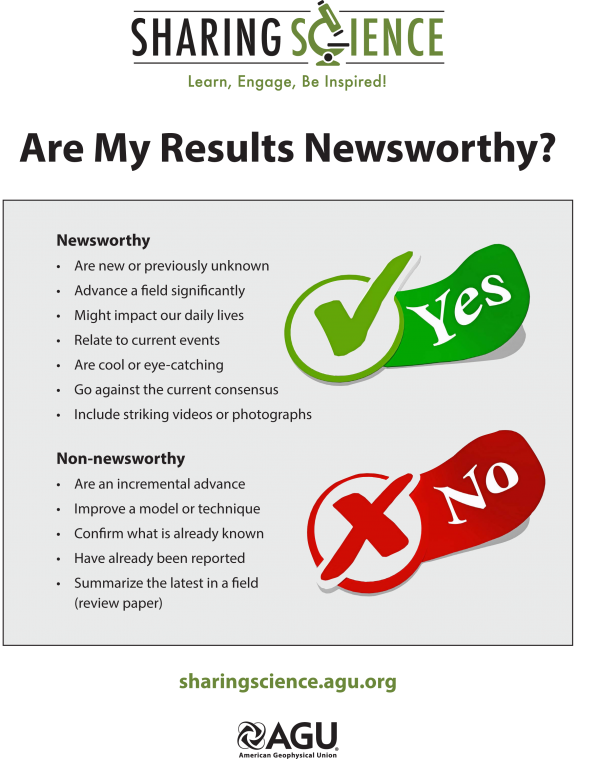9 November 2015
What makes newsworthy science? Depends on your audience.
Posted by mcadams
As a scientist-turned-journalist, I have approached scientific research from two different angles. When I was a researcher, I paid the most attention to papers that related to my specific areas of interest, and evaluated them based on how they furthered my community’s understanding of my field.
As a reporter, however, I consume new research with a slightly different set of questions in mind. I still wonder, “what do these results tell us about how the world works?” but I also have to ask myself, “will my audience be interested?”
This question gets to the essence of what makes science newsworthy. We journalists must justify the stories we report — we have to convince our readers (or viewers, or listeners, depending on the medium) to devote attention to them. And to do that, we have to demonstrate how new results relate to topics that the general public knows and cares about.
In some cases, it’s easy to drum up interest. Audiences get the importance of a new study on the probability of a Cascadia megaquake, or the latest predictions of future sea-level rise. This kind of research directly affects their lives. On the other end of the spectrum, the public has a seemingly endless appetite for stories that may lack real-world implications but that appeal to our intrinsic sense of curiosity (think of the search for extraterrestrial life, or the discovery of a giant crocodilian dinosaur).
In other cases, journalists have to do some legwork to explain the significance of a seemingly trivial or esoteric subject that actually tells us something important. For example, it’s not immediately apparent how the discovery of fossil whale bones in East Africa sheds light on the story of human evolution, but it does! Journalists often decide to cover these kinds of stories based on their own sense of newsworthiness — what they think their audiences need to know but don’t yet.
Regardless of a topic’s popularity, though, it’s hard to interest general audiences in studies that don’t reveal anything new. Although it’s extremely valuable to the scientific process to confirm previously reported findings and refine earlier results, the public just wants to know if the story has changed in a meaningful way.
For instance, it’s probably not newsworthy if a study revises the age of an ancient series of eruptions, like those that produced the Deccan Traps. But it is newsworthy if the new age sheds light on the chain of events that snuffed out the dinosaurs. A good way to find the dividing line is to ask, ‘so what?’ of a study’s results. It’s probably newsworthy if there’s a relatively straightforward and compelling answer.
This doesn’t mean that studies setting out to achieve incremental goals — for instance, to recalibrate a particular dataset — never have newsworthy outcomes. Such a study came out earlier this year, in which a fresh look at global temperature data cast into doubt the very existence of the warming “hiatus.” At the end of the day, it’s not about the novelty of the method, but the ramifications of the results.
In addition, studies that might not seem newsworthy at first glance sometimes find their way into the spotlight, usually when an outside event — like a freak storm or a political debate — draws attention to a specific question. Journalists will then go in search of scientific evidence to answer it.
Even if that evidence is equivocal (for example, the link between Pacific hurricanes like Patricia and climate change), discussing the current state of knowledge improves the public’s understanding of the issue, and the scientific process more broadly. That’s why many journalists strive to provide context whenever they report new results, which often entails retracing the evolution of an idea through years — perhaps decades — of prior studies that did not garner media attention.
At the end of the day, newsworthiness has little to do with what makes a scientific endeavor worthy. However, scientists and journalists work together better if both have a clear sense of what each looks for in new research. This mutual understanding can help ease tensions that sometimes arise between researchers (who often err of the side of underestimating a study’s significance) and reporters (who must focus on why a study matters).
It’s really a matter of remembering that each group has its own audience with its own set of interests. Scientists want to understand the processes that shape the world; lay audiences want to understand how they fit into it.
— Julia Rosen is a freelance science journalist. Her work has appeared in AGU’s Eos as well as The Los Angeles Times, Science Magazine, Nautilus and more. Rosen was also AGU’s 2014 Mass Media Fellow.
For more information about sharing science with journalists, visit AGU’s Sharing Science website, where you can find tips on preparing for interviews, resources on determining newsworthiness, and much more.



 The Plainspoken Scientist is the science communication blog of AGU’s Sharing Science program. With this blog, we wish to showcase creative and effective science communication via multiple mediums and modes.
The Plainspoken Scientist is the science communication blog of AGU’s Sharing Science program. With this blog, we wish to showcase creative and effective science communication via multiple mediums and modes.